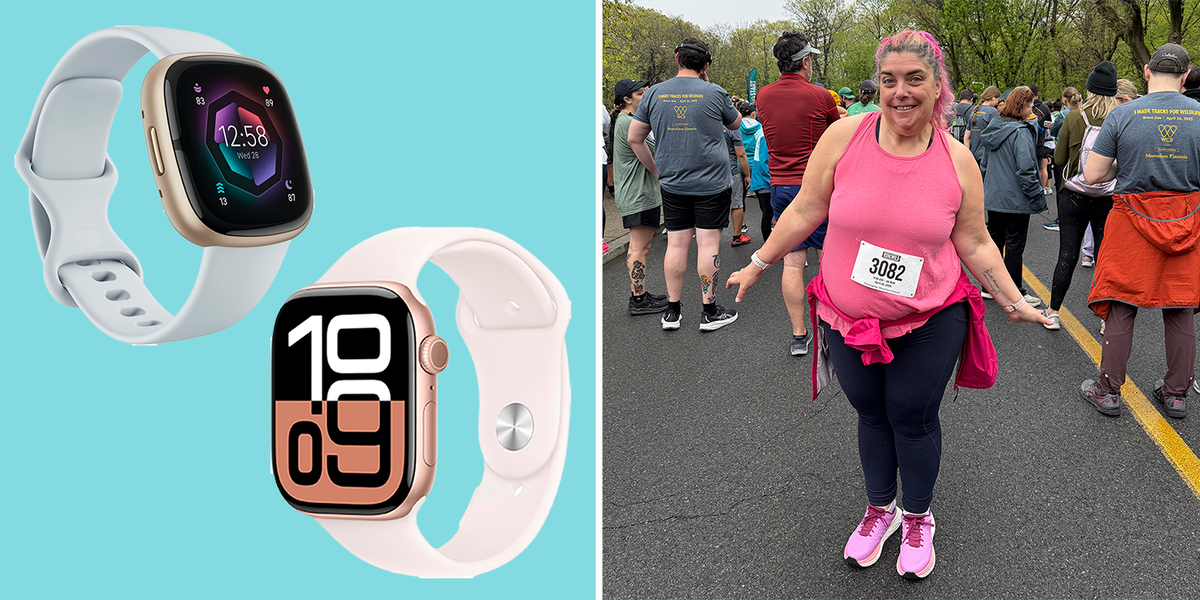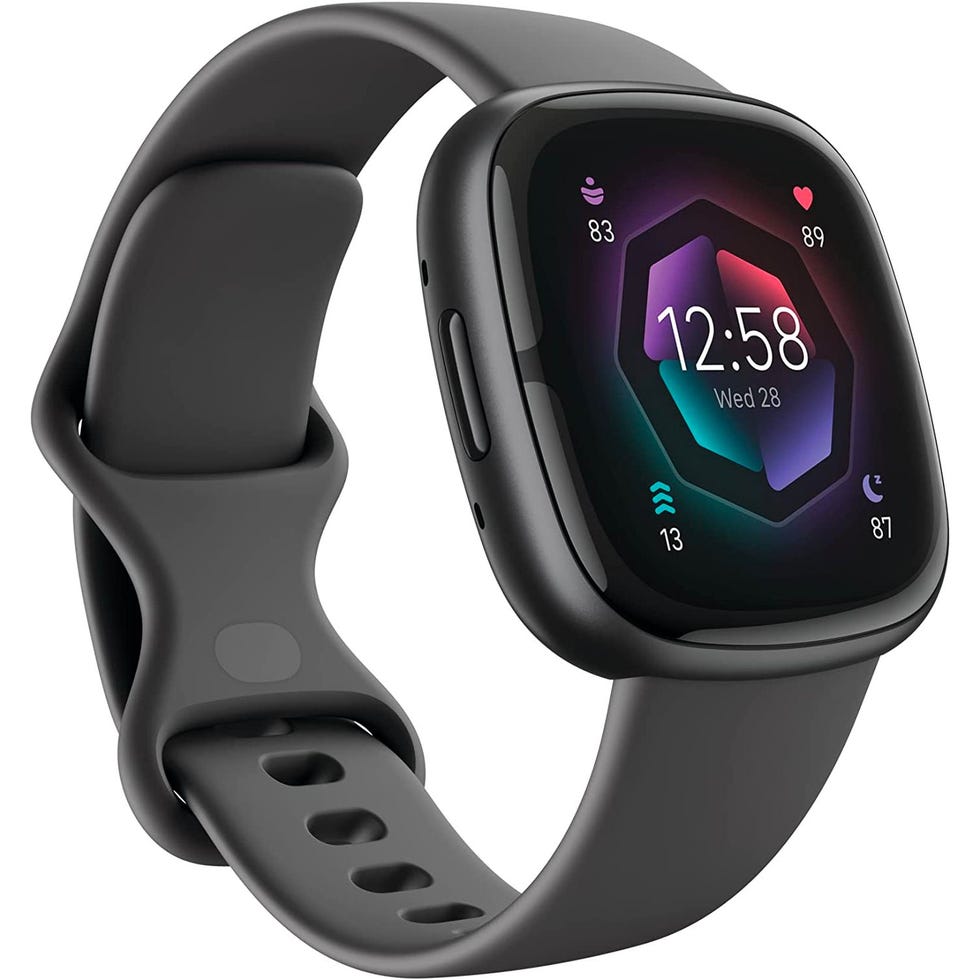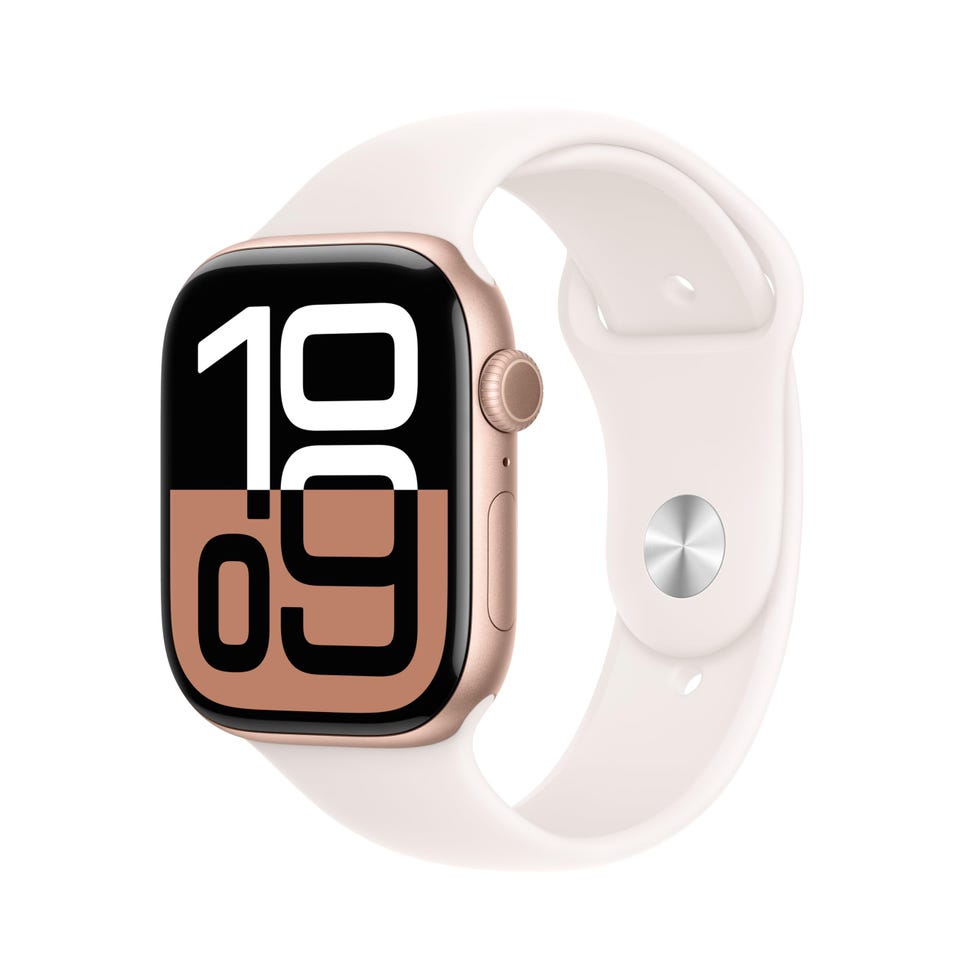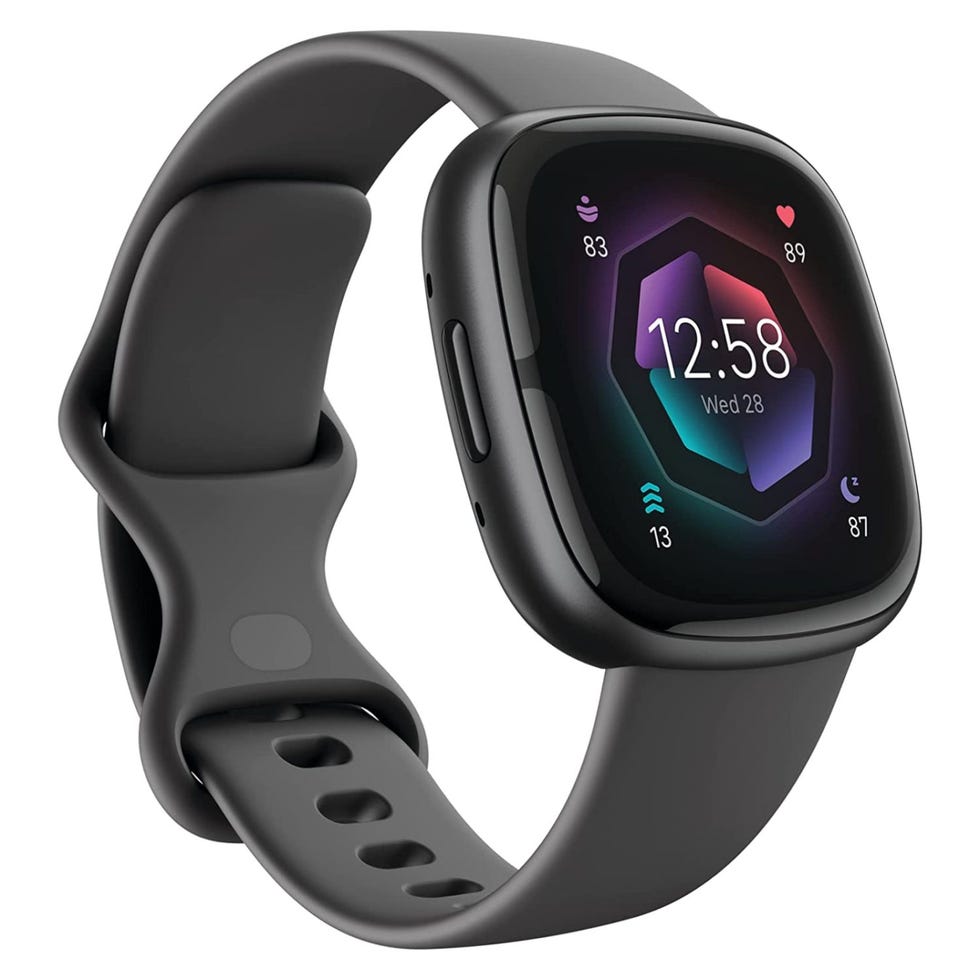I love tracking my data and stats, but in a casual way. I’m not so intense about it that I need a high-tech Garmin device that will into the minutia; I just want a smart watch to track my workouts, and (sometimes) sleep, while also being able to connect to my phone for music, calls, and texts while I’m doing my long walks.
I started off as a Fitbit loyalist—for years I wore the slim bracelet-like models to track my steps. However, as tracker tech continued to advance, I swapped to an Apple Watch, mainly for the convenience of syncing up with my iPhone and Apple Health app. But since Fitbit was acquired by Google in 2021, they have received a hefty makeover, and I have heard nothing but good things, with people even claiming it is comparable to an Apple Watch. Curious, I decided to wear the latest Fitbit smart watch—the Sense 2 —and my Apple Watch (I’ve been wearing the Series 9 for about six months) at the same time, to see exactly how they compare.
Note: My Apple Watch Series 9 is only available as renewed since the arrival of the Apple Watch Series 10. The Series 10 is very similar with a few improvements to make it more streamlined and lightweight.
If you are in the market for a new smart watch, keep reading for the in-depth results of my Apple Watch vs. Fitbit face-off, and what I think you should consider before making your purchase.
Apple Watch specs
Apple Watch Series 10
aluminum or titanium case
If you are part of the 60% of the population that uses an iPhone, the most important feature is how seamlessly the Apple Watch works with the phone. In addition to its convenience, the features and capabilities keep getting better—the Series 10 has new sleep apnea sensors, snorkeling and tide trackers, as well as a thinner and lighter design (unlike my bulky Series 9).
As a single person who spends a lot of time alone, I also appreciate that the Apple Watch has a fall tracker, in case I slip during a workout. I haven’t used the feature, but it even goes so far as to featuring a setting to notify a contact automatically after completing a workout, so they know I’ve finished safely. I also use the compass a lot while I’m hiking and appreciate that I can control my Spotify playlists from my wrist.
It comes with Siri, which makes texting on the go easy, and if you get the cellular option, you can make calls and send texts right from your watch. With the GPS-only models (which I have) you still need your phone to be in Bluetooth range in order to use phone controls, but I like being able to call directly from my watch when my phone is charging in another room or buried in my purse.
Fitbit specs
Fitbit Sense 2
The basic Fitbit was the first fitness tracker I ever owned (over a decade ago!), and it was pretty barebones. I was excited to see that the Sense 2 has a lot of the upgraded features I’ve come to rely on from a smart watch.
It is water resistant up to 50 meters, and you can wear it in the shower. The Sense 2 is Alexa-enabled (and easily connects to your Amazon account), so you can prompt it to start recording a workout or to get directions with your voice. It can also track your stress levels (so key!), skin temperature, sleep, and heart rate as well as monitoring a wide variety of workouts.
Apple Watch Vs. Fitbit: Key Differences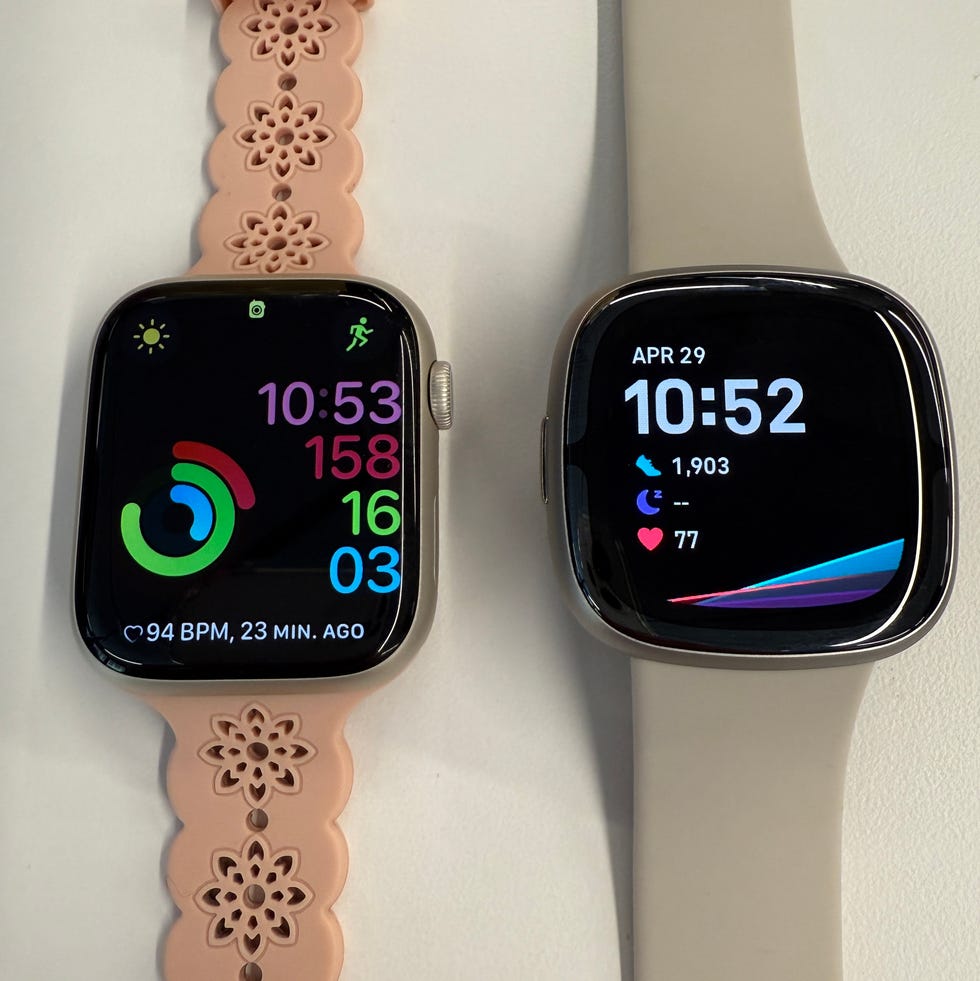 Angel Madison for Prevention
Angel Madison for Prevention
Apple Watch on the left and Fitbit on the right.
Both the Apple Watch and Fitbit track key data points, from steps to heart rate to calories burned. The Apple Watch comes in two different face sizes so you can choose if you want a larger or smaller screen, while the Fitbit Sense 2 only has one option.
On your wrist display, the Apple Watch uses color-coded rings to show you how close you are to achieving your move, standing, and exercise goals, while the Fitbit Sense 2 defaults to shows steps, sleep, and heart rate. There are alternate watch faces you can opt for with either device to showcase the metrics that are most important to you.
Battery life
The difference that caught my attention immediately was the frequency in which I need to charge the watches. The Apple Watch made it about 26 hours before the battery was totally drained, while the Fitbit went five full days before I was alerted that it needed charging. One of the main reasons I don’t often wear my Apple Watch to sleep is because I take it off to charge it before bed, so it will be ready for the next day. Otherwise, I feel like I’m missing out on some movement data while it is on the charger, and I want all my steps to count! But that means I lose out on sleep data. Friends tell me they charge their Apple Watches while they are showering, which is a good idea as it can get to 80 percent in 30 minutes, but the Fitbit can get a full day’s worth of charge in just 12 minutes.
Interface![]() Angel Madison for Prevention
Angel Madison for Prevention
Apple Watch data
![]() Angel Madison for Prevention
Angel Madison for Prevention
Fitbit data
Both smart watches use an app for storing data, but the way they present information is very different. The Fitbit app is much more streamlined: you get steps, miles walked, calories burned, and zone minutes (which are elevated heart rate/workout minutes). You can scroll down for additional metrics like sleep duration, breathing rate, and more.
The Apple Health app is jam-packed with more information than I personally need. While it still has the color coded rings, you can get everything from walking stability to headphone audio levels, along with info on how many miles you walked and the level of effort you put into a workout.
Workout tracking![]() Angel Madison for Prevention
Angel Madison for Prevention
Apple Watch workout start on the left and Fitbit workout start on the right.
Both the Apple Watch and Fitbit are designed for tracking workouts, and at the touch of a button you can identify what kind of workout you are doing—from running and biking to kickboxing or kayaking. Knowing the workout, they use your heart rate to track the effort you put in and the calories burned. For me, walking, I love to see the miles I’ve logged, along with the average pace and intensity of my workout. I appreciate that the Apple Watch uses GPS tracking to show you the route that you took, in case I want to redo a favorite walk.
One thing that I don’t love about both these trackers is that it takes a long time to recognize I am doing an activity—I am very guilty of forgetting to hit the “Start Workout” button before, well, starting a workout. Yes, they eventually realize you are expending some additional energy and ask if you want to track your workout, but it takes 10-15 minutes for Apple Watch and about 10 minutes for the Fitbit, depending on your heart rate.
The biggest difference in tracking I noticed was the Apple Watch doesn’t always count the flights of stairs I’ve climbed, and I want credit! I know that my work commute has 6-7 flights, but it often only acknowledges three, while the Fitbit counted 10 on those same days. Neither is totally precise, but I’d prefer the over-estimation. Other than the flights climbed, the data from workouts was similar on both watches.
Sleep analysis Angel Madison for Prevention
Angel Madison for Prevention
Apple Watch sleep data
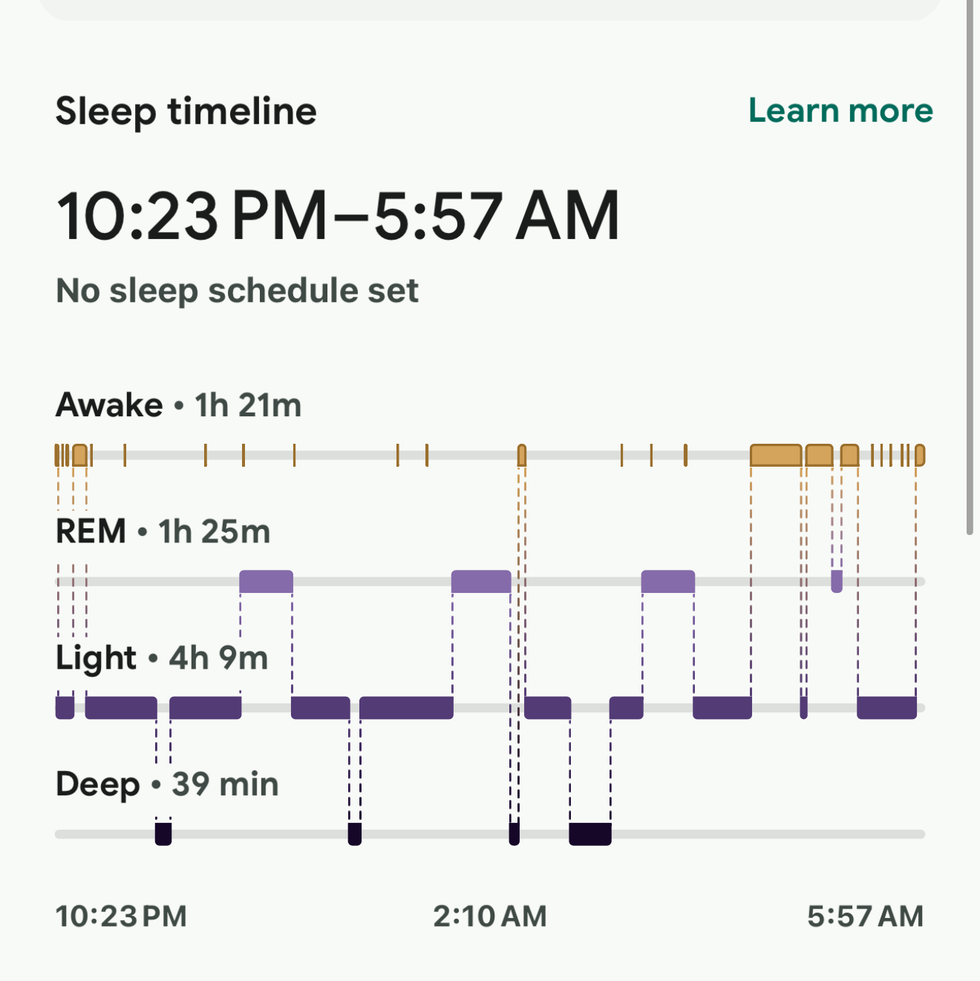 Angel Madison for Prevention
Angel Madison for Prevention
Fitbit sleep data
For sleeping, the stats were remarkably close, though for the few days I wore them both I think the Fitbit did a slightly better job of recognizing when I was awake but just laying in bed doomscrolling versus actually asleep. But as far as the light sleep, deep sleep, and REM sleep, the numbers were within a few minutes of each other, so they were both pretty spot-on. Sporadically, I tested my heart rate and ECG on both, and they were also very similar stats.
Apps and music
The biggest difference in the two devices is in the ability to use apps other than the ones built-in, which impacts the ability to listen to music from your watch. The Apple Watch doesn’t work with every app out there, but it does allow for some, like AllTrails (my go-to for hiking), Strava (to track runs/walks), and most importantly for me, Spotify (or Apple Music). While it isn’t the full version of Spotify, I can access my playlists, skip songs, and replay favorites—totally hands-free.
Unfortunately, the Fitbit Sense 2 doesn’t control music at all, nor does it support apps outside of the Fitbit plan. However, I was pleasantly surprised to discover that both devices have a Wallet app so you can tap-to-pay from your wrist, which is very convenient nowadays.
Calling and texting
Calls are also not Fitbit’s strong suit. You can receive calls on the Sense 2, but you can’t make outgoing calls. Same goes for texting. While you can see your text messages, you can’t text back. It’s frustrating, because I like to be able to respond quickly to people while I’m on a walk without digging my phone out. The Apple Watch has a Messages app, just like my phone, where I can use a tiny keyboard to text, but most often I just ask Siri to send a message and dictate what I want to say. Also for emergency reasons, I like that the Apple Watch has the ability to quickly dial 9-1-1, or reach out via text or voice memo to a friend if I need to get a quick message out.
Stress, mindfulness, reminders, and other features
Both devices have mindfulness reminders, ask you to identify how you are feeling, and offer guided breathing to help keep you calm. They will also both signal when you haven’t moved in a while. The Apple Watch will tell you to stand for a minute, while the Fitbit will show you how many steps you need towards your hourly goal.
Premium subscriptions
Apple Watch offers a three-month trial of Apple Fitness+, which is filled with a variety of workouts from yoga to HIIT, and after the trial, costs $9.99 per month. Fitbit has Fitbit Premium, and your Sense 2 purchase includes a six-month trial, after which also costs $9.99 per month. I haven’t tried either of these membership services personally, because I’m more into tracking walks, runs, and hikes than workout classes.
How I compared Apple Watch vs. Fitbit Angel Madison for Prevention
Angel Madison for Prevention
The author wearing both watches during the Bronx Zoo Run for the Wild 5K.
I’ve been wearing the two watches together for last two weeks, to see how they stack up. I have gotten some odd looks wearing a watch on each arm, but it was in the name of science! I took turns between wrists, as both recommend that you wear your watch on your non-dominant hand, but it’s easy for both devices to select which arm you have it on.
I typically walk about 12,000 or more steps per weekday, and on the weekends I’ve been training for The Great Saunter—a 32-mile walk around the perimeter of Manhattan—so I logged a few 7-10 mile training walks with both as well. I wore them both to a hilly 5K at the Bronx Zoo, so I could see if they had any major differences while running, but the data was pretty similar.
My biggest regret is not wearing both the day of The Great Saunter. I was trying to streamline my gear because it was hot outside, so I wore only my Apple Watch—which was a mistake. The Saunter took me close to 15 hours, and with the Apple Watch in workout mode, the fully-charged battery tapped out at hour 11, so I didn’t even get my entire event tracked. With the longer battery life of the Fitbit, I would have had all my data recorded, and I’m disappointed not to have this accomplishment recorded in full.
The final verdict 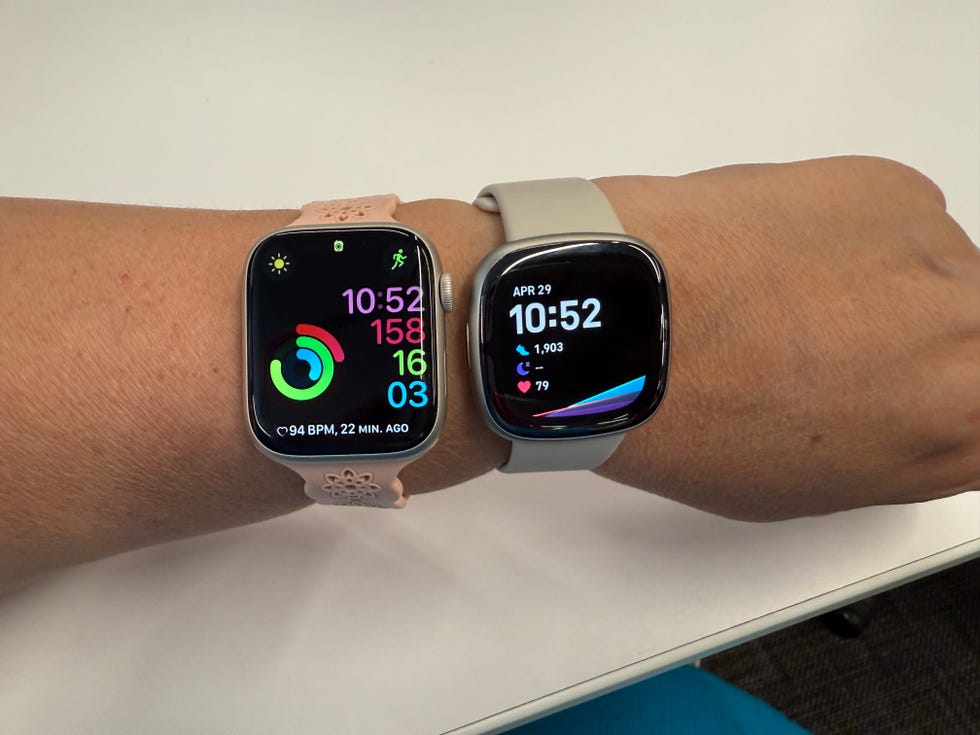 Angel Madison for Prevention
Angel Madison for Prevention
Apple Watch home screen on the left, Fitbit home screen on the right
Both are good at basic tracking, so which you select depends on the reason you are buying a smart watch. If you’re looking for a fitness tracker that is designed solely for keeping tabs on your physical and mental well-being, the Fitbit Sense 2 is a fantastic option, especially considering its much lower price tag. It easily integrates with both iOS and Android devices, since it’s from Google. It’s streamlined, easy-to-use, and the battery life is unbeatable.
If you want a wearable that can almost function as a phone replacement, the Apple Watch is the way to go. Personally, I make a lot of calls during my commute, use Spotify frequently, and need the AllTrails app to guide my hiking routes without having to use my phone. This might not be a big deal for some people, and might not justify the higher price tag, but for me it does. It’s even worth coping with the fact that it needs to be charged daily.
Now 16% Off
Now 10% Off
Related Stories
